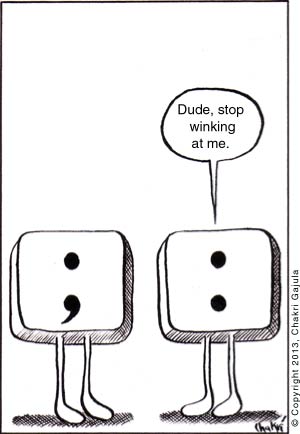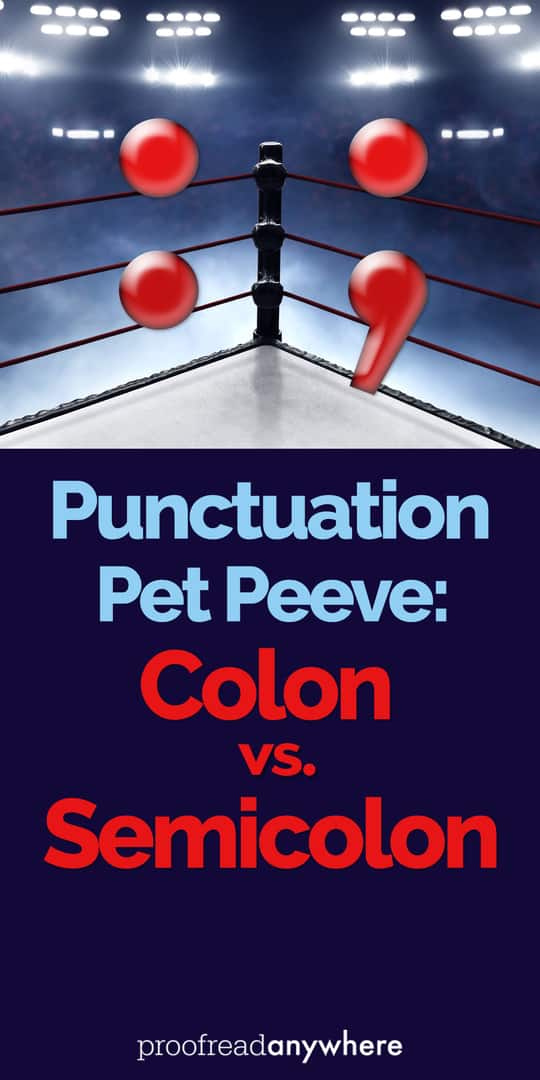I’m back with the latest installment of my Punctuation Pet Peeve series.
I’ve ranted about misused apostrophes.
I’ve condemned misplaced hyphens.
And I’ve lamented the proper use of commas.
So which punctuation marks are caught in the crosshairs today?
Today, I’m settling an age-old battle: colon vs. semicolon. If you want to work as a professional proofreader, it’s CRUCIAL you learn the difference between them. I’m breaking down exactly what each one should be used for.
How to Use a Colon
The colon is a pretty versatile punctuation mark that can be used for lots of different reasons.
-
Illustrate or underscore the previous sentence
A colon can be used to highlight the importance of the point made in the previous sentence by illustrating or underscoring it. There should be a very strong link between both sentences if you want to use a colon between them.
Example: The weather is Florida’s biggest selling point: people come here to get some sunshine.
Do you see how the second part of the sentence reinforces the first part?
It would be perfectly acceptable to use a period or a semicolon here instead, but a colon is a good choice if you want to create a sense of anticipation.
-
Introduce a list
A colon can introduce a list of words, phrases, or clauses.
Example: There are eight planets in the solar system: Mercury, Venus, Earth, Mars, Jupiter, Saturn, Uranus, and Neptune.
Sidebar: Who else is still mourning Pluto?!
-
Introduce certain quotations
A colon can be used instead of a comma to introduce a quotation, especially if you want to give the quotation more emphasis.
Example: Guess what my nightmare of a boss said to me: “You’re fired!”
That really happened to me. True story! You can read all about it here.
-
Follow certain expressions
Certain expressions are often followed by a colon like as follows or the following.
Example: An excellent proofreader has the following traits: communication skills, flexibility, and eagle eyes.
Note: Do NOT use a colon after the word including. Colons should only be used if the sentence preceding it is complete.
-
Direct address
A colon can be used after a greeting in formal correspondence.
Example: Dear Ms. Johanna:

-
Format times of day and ratios
You will often see a colon being used with times of day or in a ratio.
Example: I leap out of bed at 5:30 a.m. to proofread because I love it.
Example: 3:1 (no spaces before or after the colon)
-
Between titles and subtitles
Separate the title and subtitle of a book with a colon in running text or in a bibliography.
Example: The 7 Habits of Highly Effective People: Powerful Lessons in Personal Change
(Awesome book by the way! If you’re looking for motivational book recommendations, check out this blog post.)
-
And, of course, as emoticons!
This is the newest use of a colon. It isn’t really an official use, but feel free to have some fun with it! Include some smiley or winky faces in your writing where appropriate.
![]()
Colon FAQs
Q: Does the sentence that comes before the colon have to be a complete sentence?
A: Yes! A colon should only follow a complete sentence. If the text before the colon could not stand on its own, do NOT use a colon.
Incorrect: The three ice cream flavors she chose were: mint choc chip, butterscotch, and rocky road.
Correct: She chose three ice cream flavors: mint choc chip, butterscotch, and rocky road.
(Also correct: The three ice cream flavors she chose were mint choc chip, butterscotch, and rocky road.)
Q: Is there one space or two after a colon?
A: Do NOT use a double space after a colon. One space is enough! This applies to all punctuation marks. See my PSA at the end of this post.
Q: Should you use a capital letter after a colon?
A: Only if it introduces two or more complete sentences, the next sentence begins with a proper noun, or it introduces dialogue.
How to Use a Semicolon
By contrast, the semicolon has two main jobs. It doesn’t work half as hard as the colon, but writers misuse it more frequently.
Here’s how to use a semicolon:
-
Connects two closely related independent clauses
Semicolons can be used to connect two sentences that are closely related but that could stand on their own.
Example: Sarah went to the gym; Peter went to Krispy Kreme.
It’s not always essential to use a semicolon between two closely related independent sentences. Sometimes a period will do just fine, but if you’d like to add more variety to your writing, a semicolon will do that job nicely. Just don’t use a comma; you’d be creating a comma splice!
-
Separates items in a list
The second thing a semicolon can be used for is to separate items in a long, unwieldy list.
So we all know that the series or Oxford comma separates items in a list. But when a list comprises several items that include internal punctuation, it’s sometimes clearer to use semicolons instead of commas.
It’s all about making it easier for the reader!
Incorrect: Before I left for my epic RV trip around the country, I packed my vintage, 1950s, paper road atlas, my headlamp, which makes me look like a cave explorer, and a bag of juicy, ripe apples.
Correct: Before I left for my epic RV trip around the country, I packed my vintage, 1950s, paper road atlas; my headlamp, which makes me look like a cave explorer; and a bag of juicy, ripe apples.
Whew! Those semicolons make a difference!
Our Take
So there you have it. Another punctuation pet peeve bites the dust!
What punctuation pet peeve gets under your skin? Has the colon vs. semicolon question ever confused you? Share your confession in the comments!
Your Turn
If you enjoyed learning how to use colons and semicolons correctly and want to learn more, check out my free intro to proofreading workshop!


Great post. These examples are how I was taught years ago and also how I taught when I was a teacher but I was beginning to wonder. Lately, it looks like too many people have forgotten these basics so much to the point that misuse has become the norm, particularly the bit about complete sentence before the colon or each phrase separated by a semicolon able to stand alone. Right on. Thanks for verifying.